This post originally appeared on Parklu.com.
Commonly, the goal of brand-initiated interactions with Chinese customers is to sell something. However, this behavior runs contrary to social norms, inhibiting deeper relationships with Chinese customers and the formation of communities. Community content aims to establish or increase trust, affinity, and reciprocity, which ultimately greases the wheels of influence.
“Content is king” is one of social media marketing’s favorite clichés, but there’s a reason why it’s such a familiar refrain. When it comes to community building, content specifically created for members is an indispensable tool for the marketer.
Think of content shared within member-only channels as a gift from the brand to its community. Communities are powered by the brand’s ability to drive the desire to join or remain part of an in-group. The mere existence of member-only content incentivizes those desires, but the content also has to be valuable. Quality community content fosters affinity and trust, demonstrating the brand’s values and engaging community members who share those values.
Why create community content?#
When brands behave more like humans, in more nuanced ways, with appropriate intent, demonstrating mutual benefit, relevance, appropriate timing, and emotion, they develop stronger bonds with Chinese consumers. To succeed, brands must play a more active role in a variety of aspects of consumers’ lives. Content is one of the keys that opens a door to Chinese customers’ lives.
The best brands in China are delivering content that does not push Chinese customers to buy anything. The reason why brands are doing this is to build communities founded on pillars of communication and empathy. Community content allows brands to provide value beyond core products and services.
Let’s look at the community content loop as an input-action-output cycle. At the input stage, the brand creates and shares the content within its exclusive, private traffic channels. That content should be stimulating, engaging, and perhaps even provocative (without risking damaging the brand by dividing or alienating members, of course). The consequence should be an action in the form of lively discussion among members, who should be able to engage the brand and its representatives in conversation as well as each other.
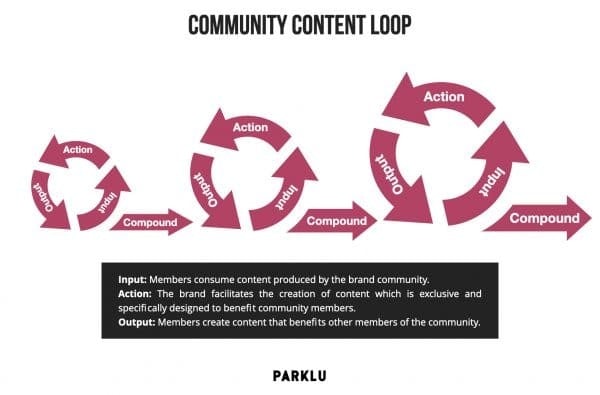
The output phase of the content loop will be a mutually reinforced sense of community among members. Fun, informative, and engaging content will be all the more powerful if it is underpinned by that sense of exclusivity. Members should be asking “Could I have got this content anywhere else?” – and the answer should be a resounding “No.”
The content creation#
philosophy#
In terms of content design itself, brands should keep a few principles in mind. All content creation should be led by value-first thinking. Community content is not a sales pitch. The brand will drive sales via its private traffic communities in other ways—exclusive, limited-edition items, member-only deals, and early-bird launches. Members will tire—quickly—of content that is too overt in pushing the virtues of the brand’s products.
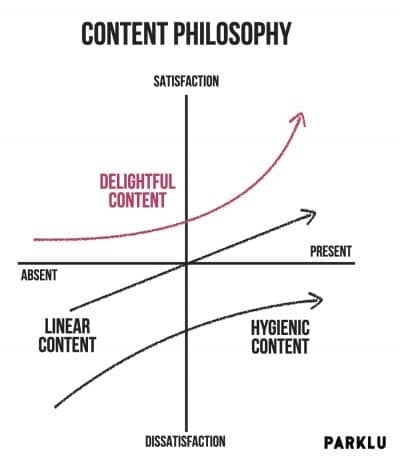
Lululemon’s workout and yoga content is a perfect example of a brand aligning its content to be highly beneficial to its customer communities as well as chiming with the consumer’s reasons for following the brand in the first place. Value-first content means going back to that idea of content as a gift from the brand. What does the consumer need from the brand? What unique value can the brand provide its members? What values does the brand share with its community, and how can that be communicated? Lululemon gets it right on each of these tests.
Brands can lead by starting conversations and asking questions. What issues matter to the brand’s member community? A clever approach to content is to feature community members, whether by interviewing them, inviting contributions from members, or featuring other types of user-generated content. Use a variety of formats, and specifically those that can be enriched by member engagement. For example, run polls or surveys, crowd-source opinions, and publish the results. Set challenges and invite members to submit their own attempts on video.
As the community matures, brands should foster more intimate links within the community. The community managers should get to know members and create a CRM that can be used to drive content design. By identifying what individual community members can add to the group, and tailoring content to create opportunities to engage members’ interests, skills, and knowledge, the community’s value will compound organically. Human touches like birthday messages can be incorporated into this strategy.
Activating social capital is another way a brand can set its member communities apart. This might mean providing members with valuable content they can share with their own peer group. Exclusive, quality content will raise a member’s social capital in their own circles, reinforcing the community’s value to the member. That could be “utility” content in the form of tutorials or practical recommendations, or the content could be entertaining and funny. Additionally, communities can elevate and celebrate member contributions and UGC within the community, thus allowing members to build status among each other.
The content pyramid#
Community content can be visualized as a pyramid. At the base is what we think of as the “pillar” content. These pieces are the foundation of content strategy for a brand community—think rich and original deep-dives into a topic, whether presented as text or video. The pillar content can and should create opportunities to collect and share UGC.
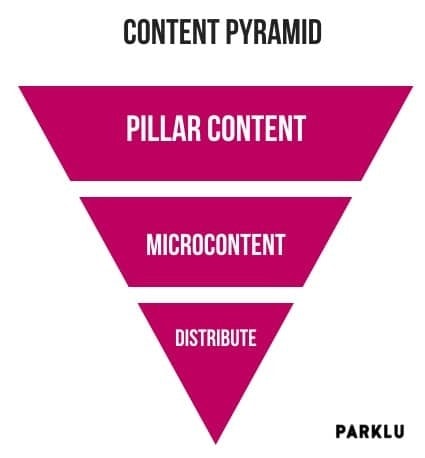
Both UGC and the original content itself can be sliced and repurposed into new content, which brings us to the next layer on the pyramid. “Micro” content uses the pillar content and UGC as a jumping-off point and helps the brand build on the momentum generated by that pillar content. Finally, the top of the pyramid is distribution—the rhythm and consistency of messaging within the brand community.
Brands should plan using a content calendar to ensure that regular slots are filled. Members should be expecting and anticipating the arrival of new content, but this routine will only become a habit for the member if the brand delivers consistently. In turn, engagement and ultimately conversions via the community will be higher if the brand keeps the content flowing. Not every content drop will be a hit, but the brand should strive to maintain quality for the benefit of the community’s long-term sustainability.
Of course, brands can also build content communities on public platforms, from traditional social media posts to the current craze for live streaming. The latter trend is worth devoting some time to, as brands like L’Oreal did during the COVID-19 lockdown. The beauty brand ran a successful series of live streams after training in-store staff to host the broadcasts, which helped to prop up sales through more than a month of store closure. Building these owned channels is a potential alternative to relying on KOL campaigns for live stream sales.
Whereas podcasts have become big business in the United States and other Western markets, audio-based communities are relatively untapped in China. User figures grew for a number of podcast apps in 2019, although Ximalaya FM dominates the category by some distance. Ximalaya FM claims its monthly active user figure has reached 135 million, and that those users listen to an average of 170 minutes of content daily.
As brands have found in other markets, podcasts are inexpensive to produce compared to some other forms of promotion. Audio is still a very new space for brands in China, but the Shanghai Pudong Development Bank has found success with an on-brand podcast about fintech. The bank’s podcast, hosted by a Chinese fintech expert, reaches an estimated 25 million listeners, ranking among Ximalaya’s top tech podcasts. This type of content is undeniably valuable to the consumer, and brands the bank as an authority in the mind of listeners.
Cases Study: Ctrip community content#
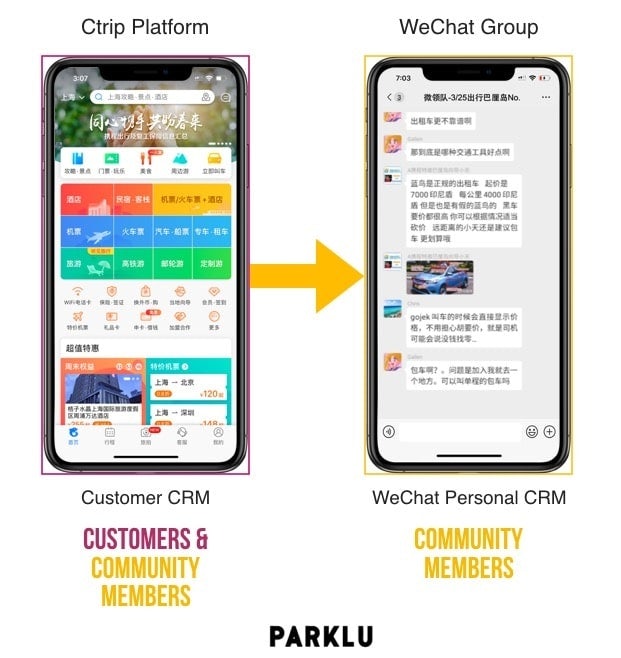
Ctrip’s virtual tour manager (VTM) is a community-driven concierge service. Users can access the VTM either within the Ctrip app, as well as via dedicated WeChat groups. Ctrip takes the VTM beyond traditional customer service, grouping Chinese customers who are traveling to the same destination around the same time into their own WeChat groups. Ctrip’s travel agents manage the groups and are available to respond to questions in real-time. They can also help travelers with trip planning, from booking restaurants and tours to organizing airport pickup. However, the community aspect allows the VTM groups to take on a life of their own, with members exchanging ideas and resources, and perhaps even arrange to meet offline during their travels.
Case Study:#
Nike community content#

Nike has made content creation and community building a centerpiece of its strategy. The brand has become virtually synonymous with running, and it has cultivated running communities in parallel to its Run Club app and sponsorship of major events like the Shanghai Marathon. In China, as in other markets, the brand has partnered with running clubs to host offline events—tapping into existing communities rather than establishing rival groups. Linking online content creation with offline events has become Nike’s specialty. For example, before the 2019 Shanghai Marathon, the brand asked eight international running clubs to share stories, run, and party with local running club members.
Nike excelled in terms of content and community during the coronavirus lockdown in China, offering free training classes, dietary guides, and meditation advice through its WeChat Mini Program and apps. The brand hosted exclusive private WeChat and Douyin Livestream training sessions with professional coaches, as well as offering public sessions.
Community tech: Chinese customers on WeChat#
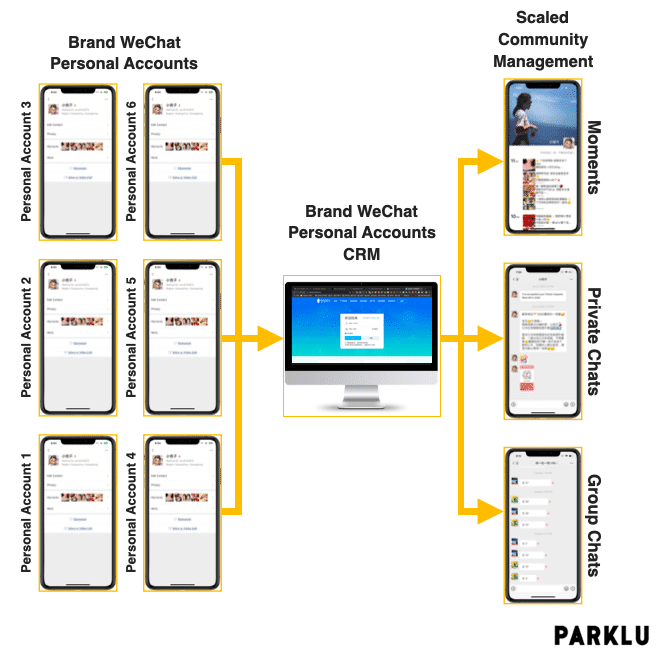
CRM tools are now widely used by China’s biggest brands to manage the brand-owned WeChat personal accounts that are used to manage private traffic communities. These allow brands to create and manage community groups segmenting Chinese customers based on a variety of demographic and preference-based categories of the brand’s choosing. Community managers can use CRMs to post within groups, post to WeChat Moments, run campaigns, and other functions.
Two of the most popular are Weiyouzhushou for Windows users and Wetool for Apple users.
